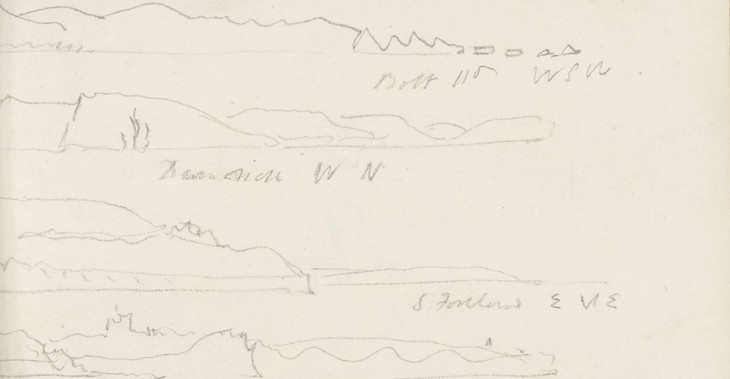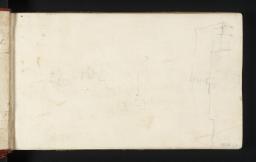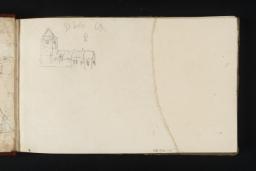From the entry
While their pages chart various meandering Kentish themes, Gerald Wilkinson articulates that the Medway and Folkestone sketchbooks of the early 1820s are connected as ‘clearly most practical studies for Rivers [of England] or Ports [of England]. The pencil is hard and the detail remarkably thorough’. What Wilkinson describes as preparation for the two series of engravings manifests itself in drawings which seek to formulate satisfying and evocative arrangements of topographic and architectural features observed regularly from a viewpoint on the water. That is to say, a large proportion of sketches in each of the books have been composed from the deck of a boat, or from vantage points conducive to representing the relationship between land and sea, or river. Turner had an affectionate relationship with the Kent landscape. Such was his great fondness for the Medway, that he ‘encouraged the notion of his being a Kentish man’. David Blayney Brown describes ...
References
While their pages chart various meandering Kentish themes, Gerald Wilkinson articulates that the Medway and Folkestone sketchbooks of the early 1820s are connected as ‘clearly most practical studies for Rivers [of England] or Ports [of England]. The pencil is hard and the detail remarkably thorough’.1 What Wilkinson describes as preparation for the two series of engravings manifests itself in drawings which seek to formulate satisfying and evocative arrangements of topographic and architectural features observed regularly from a viewpoint on the water. That is to say, a large proportion of sketches in each of the books have been composed from the deck of a boat, or from vantage points conducive to representing the relationship between land and sea, or river.
Turner had an affectionate relationship with the Kent landscape. Such was his great fondness for the Medway, that he ‘encouraged the notion of his being a Kentish man’.2 David Blayney Brown describes how, whilst at the Academy Schools, Turner encountered the watercolourist and drawing master William Frederick Wells (1762–1836), who owned a cottage in Knockholt. Invitations to stay there were extended to Turner by his new acquaintance, and the country retreat became a place of escape at the time of his mother’s ‘mental collapse’ in 1800.3
The dating of this section, comprised of only a pair of sketchbooks, rests upon a number of points. First, the watermarking of the paper bound into the volumes dates the manufacture of the Folkestone book to 1819, the Medway to 1820.4 Evidently, this rules out their use prior to those years. In addition, the Medway sketchbook supplied material for the watercolour Rochester, on the River Medway, of 1822 (Tate D18156; Turner Bequest CCVIII W),5 engraved by Thomas Lupton for the Rivers of England series and published in January 1824 (Tate impressions: T06370, T04796–T04798). This narrows the period during which the volume could have been in use to between 1820 and 1822. More information about the scholarly dialogue surrounding the dating of this book can be found in the Medway Introduction, alongside details of further finished watercolours influenced by sketches composed within its pages.
David Blayney Brown articulates that drawings in the Folkestone sketchbook form the basis of Turner’s watercolour for Folkestone of about 1823 (Taft Museum of Art, Cincinnati),6 engraved by R. Wallis and published in 1826 as part of W.B. Cooke’s Picturesque Views on the Southern Coast of England (Tate impressions: T05997 and T05254).7 The relationship between Turner and Cooke was friendly, although Wilkinson suggests that neither party could have been profiting much, in a financial sense, from the series.8 Brown also finds that this sketchbook contains Dover views which may have influenced Dover, from Shakespeare Cliff of about 1824 (currently untraced),9 engraved by G. Cooke and also published in 1826 for Southern Coast (Tate impressions: T04424, T05246–T05251, T06000).10
On the strength of autobiographical evidence, sketches of Oxford in the Folkestone volume (Tate D40685, D17207–D17210, D17214, D17234, D17356–D17357; inside the front cover and Turner Bequest CXCVIII 1, 1a, 2, 2a, 5, 17, 87a, 88) have provoked an agreement that the pages were filled during a period immediately following the death of Turner’s uncle, J.M.W. Marshall, in June 1820, when Turner travelled to visit his aunt in Sunningwell, Oxfordshire.11 There is also a rent receipt inscribed on the final folio of the sketchbook, dated April 1821 (Tate D17364; Turner Bequest CXCVIII 91a). Sketches of the Episcopal Chapel at Sandgate, consecrated in May 1822, expand the dating of the volume to encompass that year. For a more detailed commentary on all of these points, refer to the Introduction to the Folkestone sketchbook.
How to cite
Maud Whatley, ‘Folkestone and the Medway c.1821–2’, January 2016, in David Blayney Brown (ed.), J.M.W. Turner: Sketchbooks, Drawings and Watercolours, Tate Research Publication, February 2017, https://www



